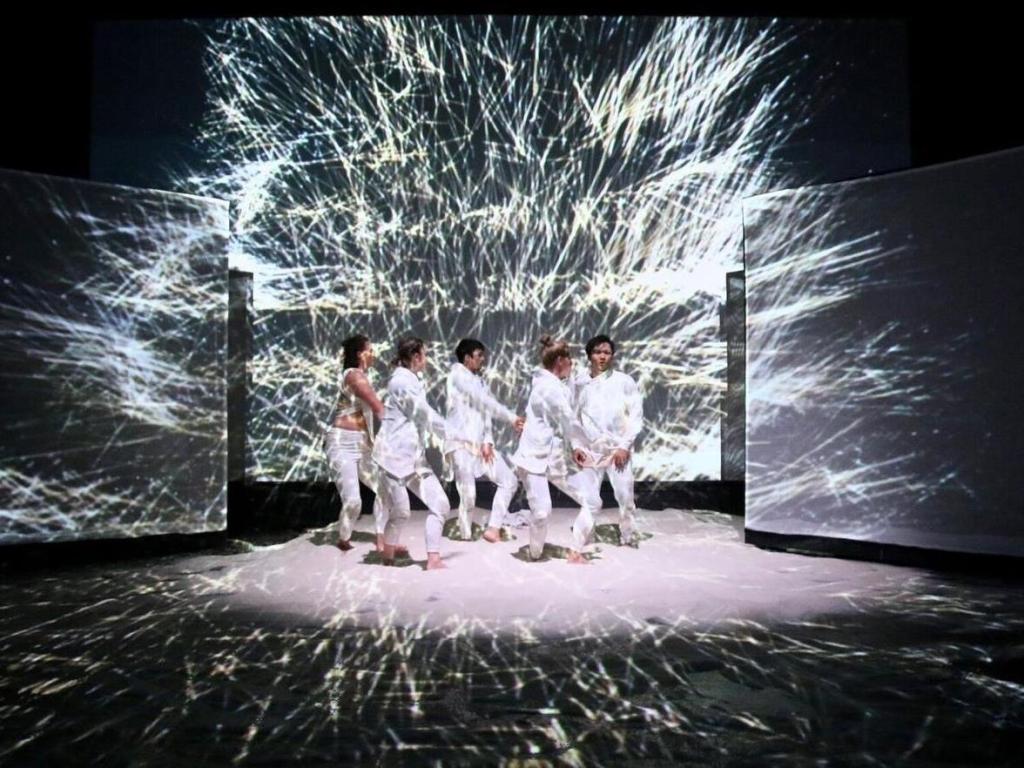Dark Matter presented by PRAXIS Collective and Performing Lines WA. Photograph by Emma Fishwick.
Dark Matter is part of the MoveMe Festival celebrating dance in Perth. The group behind Dark Matter, PRAXIS – as a collective of choreographer, visual artist and musician – have found common themes to explore. The idea of multidisciplinary work exploring significant topics is interesting – in this case it is about dark matter – in which emergence of life, chrysalises taking shape. The exploration of the body in the environment are the visible themes. The program says that the inspiration for the piece is about ‘our natural need to blend in and form new communities’ and ‘explores the ways in which life forms evolve and adapt in new surroundings’ in thinking about the 65 million displaced people around the world, and that drought and natural disasters may someday mean finding a new living environment.
However the work feels constricted ultimately by some of its excellent key ideas. One of which is performing on ‘sand’ (actually rice) and the images this creates early on are unusual and beautifully evocative, however through the dance piece it becomes apparent that stepping on/sliding over sand/rice is too difficult to be able to experiment with movements that create a leaping off/leverage, and so we get more sliding movements, more ‘emergent from the dust’ analogies which is ultimately limiting and repetitive for the work. The performers: Imanuel Dado, Harrison Elliot, Storm Helmore, Isabella Stone and Ella-Rose Trew do a sterling job in arching and stretching and scissoring movement through their rice scattered stage.
Similarly, the video installation/screen work (by Alexander Boynes) is an effective idea – to have a montage of images relating to the work and for the dancers to be seen across/in the screens – but the physical movement of the two tall 3D screens by the dancers and the blocking of them in one section where they dance in between the two screens placed horizontally so that the audience sees very little and can really only engage with their projected shadows vaguely seen are again ultimately limiting. The most effective imagery included when one of the dancers performed on stage and an image of the dancer’s movements was echoed on the video installation work, with heat radiant imagery coming off the elongated somewhat body shape.
The performance starts with soundwave-like images swirling up the screen that morph into a type of atomic mushroom cloud with red edges emanating out – my companion found this an endurance – but as most of the stage was dark with only hints of movement of bodies behind the screen, it seemed more meditative to me. The performers, redolent of emergent life slowly arise from their nest of sand, they stare out at the audience as if the new world had suddenly appeared. This first part of Dark Matter I found engrossing. They perform slow motion movements as if testing gravity and push sand out as if in conquering more land. Their faces subsume then emerge from the sand in various movements that are highly effective. Once the granules are further sprayed out the lighting effects are quite wonderful. We are distracted by what looks like internalised blood vessels as part of the video installation and then Ink Blot type patterns periodically appear. The dancers must be deliberate with each other and they counterbalance in push/pull type movement so as not to lose their footing. One of the most poignant movements was the gripping of each other’s arms whilst facing each other and slowly lowering to the ground. Later one of the girl dancers emerges from her chrysalis, loses her white jacket and arises unsteady of her feet. Here the choreography lost credibility. This movement of being unsteady on your feet, like kittens just been born with shaky steps, was performed once and repeated at later stages by other dancers. It somehow did not ring true as a dance movement for an experienced dancer.
The sound design and live music performance by cellist Tristan Parr is highly emotive and focused on dark swirling emotional states. At times it drives the performance; and at others an overall melancholy in the music seems to emphasise abandonment and end of days. The music did create an emotional urgency through bass and drum percussive sounds at times, and it was great to see the integration of live music.
Towards the end the dancers walk through the sand/rice making long tracks back and forth. I think of the repetition of the working life; and chastise myself for constantly thinking of metaphors as the work progresses, however I am distracted and the movements are not sufficiently energetic or engaging to keep my attention, as I recall the brilliance of the first half of Dark Matter.
Rating: 3.5 out of 5 stars
Dark Matter
Choreographer Laura Boynes
Video/Installation Artist Alexander Boynes
Cellist/Composer Tristen Parr
Projection Mapping Roly Skender
Costume Design Imogene Spencer
Lighting Design Chris Donnelly
Dancers Imanuel Dado, Harrison Elliot, Storm Helmore, Isabella Stone, Ella-Rose Trew.
Studio Underground at WA State Theatre Centre
As part of MoveMe Festival 2016
15–18 September 2016





